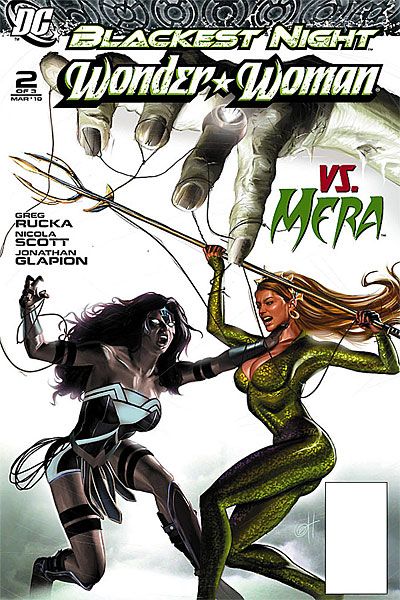This story takes place somewhere in the nebulous dark gray areas of the "off-panel" realm between pages 12 and 20 of "Blackest Night" #6. Don't cling too tightly to the timing of it all. Suffices to say, it happened off to the side of the main action in "Blackest Night." This current set of "Blackest Night" tie-in miniseries is oddly timed out. In this instance, "Blackest Night: Wonder Woman" seems less like a coherent linear tale and more like a collection of Wonder Woman's adventures during "Blackest Night."
I'm sure this presents a bit of a challenge to Rucka and Scott (and Pansica), who were writing and drawing a perfectly fine Wonder Woman in the first issue. This issue, however, features Wonder Woman as a Black Lantern set to claim the lives of her allies. An odd switch to be sure. While this issue starts out with Diana being influenced by the Black Lantern ring, Rucka delivers an epic struggle within Diana against the power of the ring. As has been seen in "Blackest Night" #6 as well as on the cover to "Blackest Night" #7, Diana becomes a Star Sapphire, embodying the power of love. After all, in the DC Universe, who better to do so than Diana?
Mera's story in this issue is one of determination and rage. As one of the characters with the most level disposition at the onset of the "Blackest Night" event -- despite facing her husband, countrymen, and romantic rivals -- Mera submits to rage to counter the fierceness of Diana's attack.
Rucka's story is a fast read, but a read that beckons the reader to come back and have another look. While Diana wrestles with the Black Lantern ring, Rucka plays out the Avenging Amazon's worst nightmares made real, but he offers her redemption at the end of the issue.
Rather than appear foolish in trying to delineate between the artwork of Scott and Pansica, I can only label the art in this issue as dreadfully beautiful. Both artists rely heavily upon the use of shadow to influence the color choices from Nei Ruffino. This book is visually dark, as dark as the heart-stealing subject matter contained on these pages, which makes the shining metal of Hippolyta's armor, the heroic primary hues of Cassie's costume, and all of Mera (from her hair to her sea-green eyes to her bloody nose) pop out of the panel. The colors of life sing to the reader from the darkness of "Blackest Night" and in the turning point of this story, those colors shine even brighter.
This series, like all of the "Blackest Night" tie-ins, offers more to the story. It doesn't supplant "Blackest Night," but it enhances what happens in the main title. No one reading "Blackest Night" is going to be lost if they skip this issue, but those reading this issue will have some questions about "Blackest Night" #6 quickly answered.

